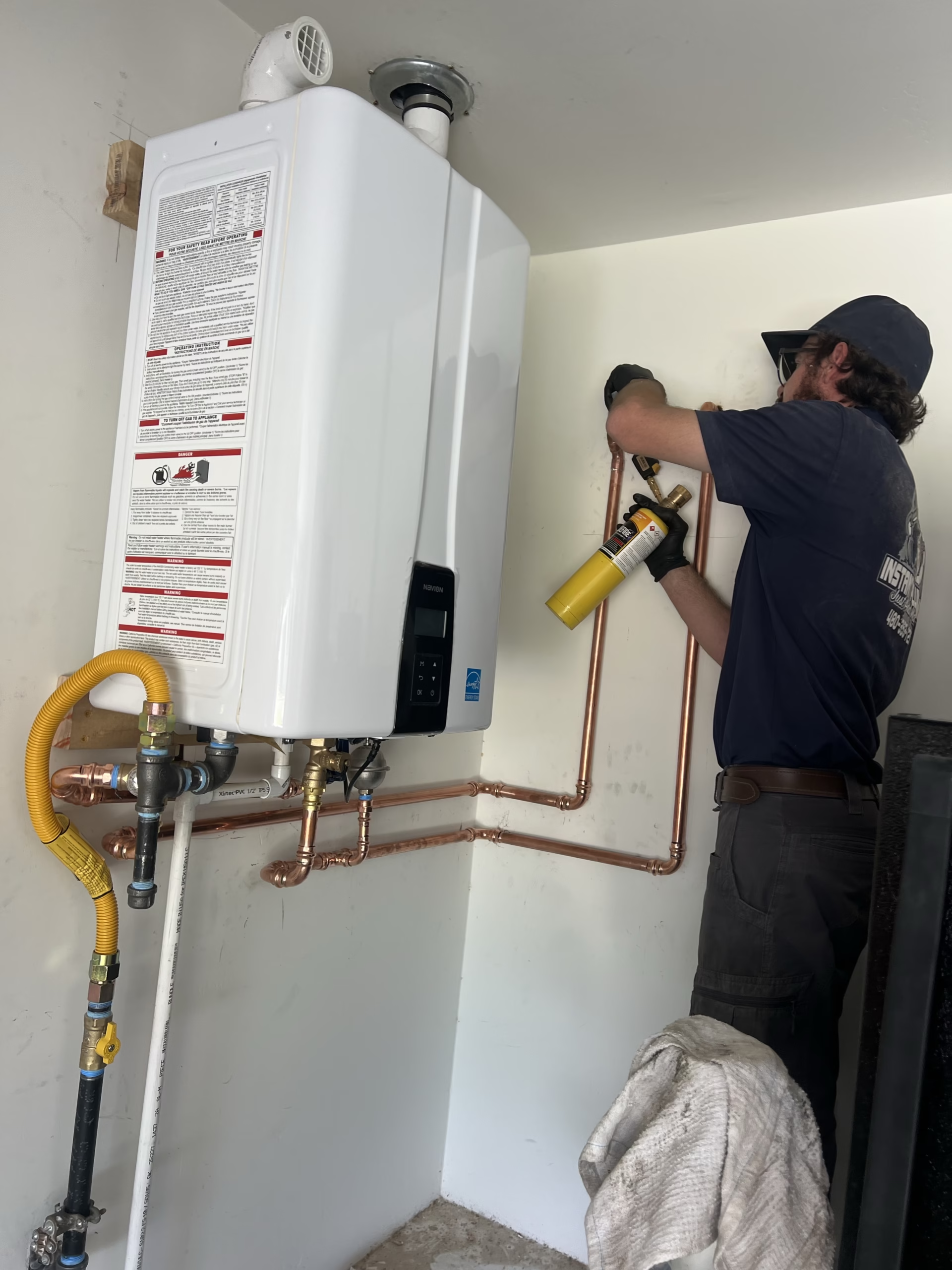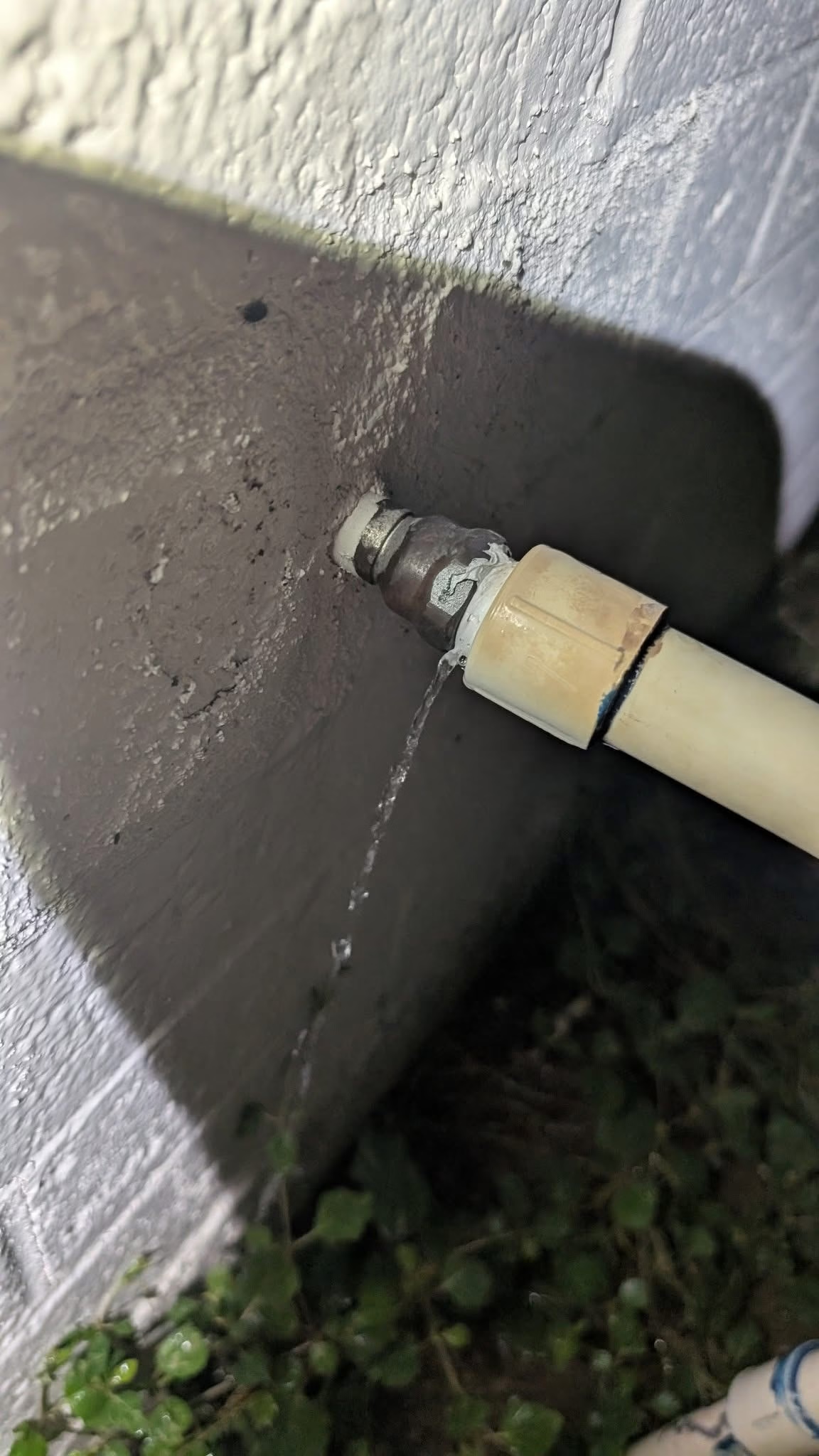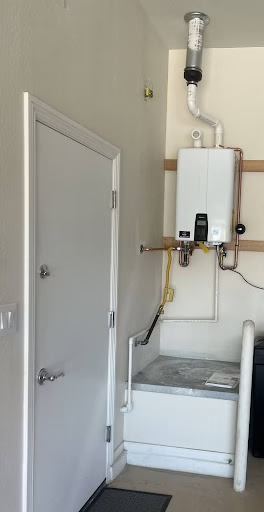Picture this: It’s a beautiful sunny day here in Phoenix. You’re out in your yard, maybe watering your prized rose bushes, filling up the kids’ kiddie pool, or hosing down the patio after a dust storm. You grab your garden hose, connect it to your outdoor faucet – what we plumbers call a “hose bib” – and get to work. Everything feels normal, safe and just another part of homeownership.
But what if we told you there’s a silent, unseen danger lurking in that seemingly simple connection? A threat that could turn your sparkling drinking water into something potentially harmful, right inside your home’s pipes? It’s a thought that can send a shiver down any homeowner’s spine: Is my family’s water supply truly safe? Are we accidentally letting something nasty back into our drinking water without even knowing it?
At Instant Plumbing, serving homes across Glendale, Phoenix, Scottsdale, Peoria, Mesa, Tempe, Chandler, and beyond since 2001, we understand these worries. You care deeply about your home and most importantly, the health and safety of your loved ones. The idea that something as common as a garden hose could put your drinking water at risk isn’t just unsettling; it’s genuinely frightening. You want peace of mind, and you deserve to feel confident that every sip of water from your tap is clean and pure. That’s precisely why we’re obsessed with sharing crucial knowledge like the importance of vacuum breakers on hose bibs – not to scare you, but to empower you with the understanding needed to protect your home and family. Let’s shine a light on this hidden danger and discover a simple solution: the humble, yet incredibly mighty, vacuum breaker.
What is a Vacuum Breaker and Why Does it Matter for Your Hose Bib?
When you think about your home’s plumbing, you probably imagine water flowing in one direction: from the street, into your house, and out through your faucets or drains. And for the most part, that’s how it works! But there are specific situations where that flow can actually reverse, pulling unwanted stuff back into your clean water supply. This unwanted reversal of flow is called backflow.
Defining Backflow and How it Occurs
Imagine sipping a drink through a straw. If you stop sipping, the liquid stays in the straw. But if you suddenly suck air out of the straw from the top while the bottom is in liquid, that liquid will rush up the straw. That’s a bit like how backflow works in your pipes.
In plumbing, backflow happens when the water pressure in your home’s water pipes suddenly drops, often due to things like a main water line break down the street, a fire hydrant being opened or even just heavy water usage elsewhere in your neighborhood. When this pressure drop occurs, it can create a vacuum, or a “sucking” action, within your pipes. If a hose is connected to an outdoor faucet and its end is submerged in contaminated water (like a bucket of dirty car wash water, a kiddie pool or even a puddle from deep watering a tree), that vacuum can literally pull the dirty water backwards into your home’s fresh water lines. It’s not just a theoretical problem; it’s a real and documented risk.
The Role of a Vacuum Breaker in Preventing Contamination
This is where the vacuum breaker steps in, acting like a vigilant guardian for your water. A vacuum breaker is a small device designed to prevent backflow by allowing air to enter the pipe when a pressure drop occurs. Think of it like a tiny, smart valve that knows when things are going wrong.
When the water flow reverses and a vacuum tries to form, the vacuum breaker opens up, letting in a burst of air. This rush of air breaks the vacuum, stopping the contaminated water from being sucked back into your drinking water system. It’s a simple, yet incredibly effective, safety feature that creates an air gap, ensuring your clean water stays clean.
Why Standard Hose Bibs Aren’t Enough
Many older homes, and even some newer ones, might have hose bibs without built-in backflow prevention. These standard outdoor faucets are designed to deliver water, but they don’t have the internal mechanism to protect against backflow. This means if you attach a regular hose to them, and that hose end gets submerged in something questionable, your home is vulnerable. Relying solely on a basic hose bib is like leaving your front door unlocked – it might be fine most of the time, but you’re taking an unnecessary risk.
The Hidden Dangers: Understanding Water Contamination Risks
The concept of backflow might sound technical, but the risks it poses are very real and can hit close to home. Understanding what can contaminate your water and the potential health consequences highlights why devices like vacuum breakers aren’t just an option, but a necessity and a code requirement.
Protecting Your Drinking Water: Cross-Contamination Explained
The main concern with backflow is cross-contamination. This is when non-potable (not safe for drinking) water mixes with potable (safe for drinking) water. Your home’s plumbing system is designed to keep these two types of water separate. When backflow occurs, this critical barrier is breached, and suddenly, what you use to water your lawn could end up in the water you use to brush your teeth.
Common Household Contaminants and Their Sources
It’s easy to think, “What could really get into my water?” The truth is, common activities around your home can inadvertently create hazards.
Pesticides and Herbicides from Garden Hoses
You’ve just sprayed your lawn or garden with weed killer or pest control. If your hose is left sitting in a bucket of the chemical mixture or even a puddle where these chemicals have run off, a sudden pressure drop could pull those toxic substances right into your home’s plumbing. Imagine drinking water that now contains traces of something designed to kill weeds and bugs.
Soapy Water from Car Washing
After a satisfying car wash, your hose might be lying in a pool of dirty, soapy water. While soap isn’t as acutely dangerous as pesticides, do you really want to be showering in water that contains leftover car soap and road grime?
Pool Chemicals and Standing Water
Filling up or draining a swimming pool often involves submerging a hose. Pool water is treated with chlorine, algaecides and other chemicals. If a backflow event happens while your hose is in the pool, these chemicals can easily be siphoned back into your domestic water supply. Similarly, stagnant water in buckets, ponds or even overflowing pet bowls, if connected to a submerged hose, can introduce bacteria and other pathogens.
Health Risks Associated with Contaminated Water
The consequences of drinking or using contaminated water can range from mild discomfort to serious illness. Depending on what gets pulled back into your system, you could experience:
- Gastrointestinal issues: Nausea, vomiting, diarrhea from bacteria or other microorganisms.
- Skin irritation: From chemicals like chlorine or strong soaps.
- Poisoning: Ingesting pesticides or other hazardous chemicals can lead to severe health problems, potentially requiring immediate medical attention.
- Long-term health effects: Repeated exposure to certain contaminants, even in small amounts, can have cumulative effects on health over time.
This isn’t just about a bad taste or smell; it’s about safeguarding your family from preventable illnesses.
Local Regulations and Why They Mandate Vacuum Breakers
It’s not just about good practice; in many areas, including throughout the valley, local plumbing codes and health regulations actually require the use of backflow prevention devices, including vacuum breakers on outdoor hose bibs. These regulations exist precisely because the risk of water contamination is so significant. Municipalities want to protect the public water supply and, by extension, every home connected to it.

How Vacuum Breakers Work: A Simple Explanation
Understanding the “why” makes the “how” even more interesting. Vacuum breakers, though small, are clever devices that use basic physics to create a critical safety barrier.
Types of Vacuum Breakers for Outdoor Faucets
While several types of backflow preventers exist for different plumbing applications, for your standard outdoor hose bib, you’ll most commonly encounter two types:
Atmospheric Vacuum Breakers (AVB)
These are the most common and often the simplest type. An AVB has a poppet valve (a little disc that opens and closes) that is held down by water pressure when water is flowing in the correct direction. If the water pressure drops and a vacuum begins to form, the poppet valve lifts, allowing air to rush into the hose bib. This air breaks the vacuum, stopping any contaminated water from being pulled back. AVBs are usually permanently installed on the hose bib or screw onto the threads.
Pressure Vacuum Breakers (PVB)
Pressure Vacuum Breakers (PVB’s) are a bit more complex and are often used for irrigation systems and pool fillers, though they can be found on some hose bib setups. They contain a spring-loaded check valve and an independently operating air inlet valve. This design allows them to operate under continuous pressure, making them suitable for situations where water might be left on for extended periods, like with drip systems. While more robust, they also tend to be larger and more expensive than AVBs. For a simple hose bib, an AVB is usually sufficient.
The Mechanics of Preventing Back-Siphonage
The core principle is to “break the siphon.” When water is being pulled backward, it’s essentially creating a siphon effect. The vacuum breaker’s job is to introduce air into the system before the siphon can fully establish itself and pull contaminants.
Think of it like this: If you’re trying to drink from a straw, and someone pokes a hole in the side of the straw above the liquid, you won’t be able to suck anything up because you’ll just be sucking air. A vacuum breaker does the same thing for your water pipes, creating that “hole” (an air gap) precisely when it’s needed most to protect your water.
When and Where to Install a Vacuum Breaker
The ideal place to install a vacuum breaker is directly onto your outdoor hose bib, before any hose or attachment. Some modern hose bibs come with integrated vacuum breakers, often identifiable by a slightly bulkier head or a non-removable cap over the nozzle. If yours doesn’t have one built-in, you can easily screw on an external atmospheric vacuum breaker to the threads of your existing hose bib. It’s a quick, simple addition that provides immediate protection. Every single outdoor faucet that can have a hose attached should have one.
Installation, Maintenance, and Troubleshooting Your Vacuum Breaker
Knowing about vacuum breakers is one thing; making sure they are correctly installed and working properly is another. While these devices are generally simple, a little knowledge goes a long way in ensuring continuous protection.
DIY vs. Professional Installation: What You Need to Know
For a standard screw-on atmospheric vacuum breaker, DIY installation is typically straightforward. You simply thread it onto your existing hose bib. However, for more complex systems like those involving pressure vacuum breakers (PVBs) for irrigation, or if your hose bib requires a more permanent, integrated solution, it’s highly recommended to call a licensed plumber. Professionals like those at Instant Plumbing have the tools, expertise and knowledge of local codes to ensure proper installation and functionality.
Routine Maintenance Tips for Longevity
Vacuum breakers are generally low-maintenance, but a few simple checks can ensure they remain effective:
- Visual Inspection: Periodically check the device for any visible cracks, leaks or damage.
- Remove During Winter (in colder climates): While we don’t have harsh winters that often freeze pipes solid here in Phoenix, if you were in a colder climate, you’d remove screw-on vacuum breakers before winter to prevent freezing and damage. Here in AZ, you can generally leave them on.
- Check for Continuous Leaks: A small drip right after use might be normal, but a continuous leak usually indicates a problem and requires replacement.
Identifying a Malfunctioning Vacuum Breaker
A non-functioning vacuum breaker is a silent danger. Here are signs it might be failing:
- Constant Dripping or Leaking: If water constantly leaks from the vacuum breaker’s air vent even when the hose is not in use or during normal flow, it’s likely faulty.
- No Air Release: If you suspect a backflow event (e.g., major pressure drop) and don’t see or hear air being drawn in (which might be hard to observe), it could indicate a problem.
- Visible Damage: Cracks, corrosion or a broken air vent.
- Age: Like any plumbing component, they don’t last forever.
What to Do If Your Vacuum Breaker is Leaking or Not Working
If you notice your vacuum breaker is continuously leaking or appears to be malfunctioning, the best course of action is to replace it immediately. For screw-on models, you can purchase a new one and install it yourself. However, for integrated hose bibs or more complex backflow preventers, it’s always wise to contact a licensed plumber. Attempting to repair a damaged unit yourself often isn’t cost-effective, and a faulty repair could leave your water supply unprotected.
Ensuring Your Home’s Water Safety: A Proactive Approach
Ultimately, protecting your family’s water supply comes down to being informed and proactive. It’s about understanding the potential risks and taking the simple, preventative steps that make all the difference.
Regular Plumbing Inspections for Backflow Prevention
Just like you get your car’s oil changed or your AC unit serviced, scheduling regular plumbing inspections can identify potential backflow risks you might not even be aware of. A professional plumber from Instant Plumbing can assess your outdoor hose bibs, irrigation system connection and other vulnerable connections to ensure all necessary backflow prevention devices are installed and functioning correctly. This peace of mind is invaluable.
Understanding Your Responsibilities as a Homeowner
As a homeowner, you are the first line of defense for your family’s health and safety. Taking a few minutes to walk around your property, especially areas where you use hoses, and being aware of the substances your hose might come into contact with, is crucial. Knowing that a small device like a vacuum breaker can prevent a serious problem is empowering.
When to Call a Licensed Plumber for Backflow Concerns
While some backflow prevention tasks are DIY-friendly (like screwing on an AVB), don’t hesitate to call a licensed plumbing professional if:
- You’re unsure if your hose bibs have proper backflow prevention.
- You need a new hose bib installed or replaced with an anti-siphon model.
- You have an irrigation system and need its backflow preventer inspected or repaired.
- You notice any leaks or issues with existing backflow prevention devices.
- You have concerns about any other potential cross-connection points in your home.
Here at Instant Plumbing, serving Glendale, Phoenix, Scottsdale, and the surrounding cities, we’re not just about fixing leaks; we’re about ensuring your home’s entire plumbing system, and the water it delivers, is safe and sound. We’re here to help you navigate these important issues with clear advice and expert service.
Don’t Compromise on Water Safety
The thought of contaminated drinking water is unsettling, but the good news is that preventing it, especially from your outdoor hose bibs, is remarkably simple and affordable. A vacuum breaker is a small investment that offers colossal protection for your family’s health and your home’s water supply. Don’t let a moment of unawareness or a sudden pressure drop turn an everyday task into a health hazard. Take a quick look at your hose bibs today, and if they’re not protected, make the easy choice to install a vacuum breaker. Your peace of mind, and your family’s safety, are well worth it.
Frequently Asked Questions
Q: What is the main purpose of a vacuum breaker on a hose bib?
A: The main purpose of a vacuum breaker on a hose bib is to prevent contaminated water from being sucked back into your home’s clean drinking water supply, a process known as backflow or back-siphonage. It does this by allowing air into the pipe if pressure drops, breaking the vacuum.
Q: Can I install a vacuum breaker myself, or do I need a plumber?
A: For basic screw-on atmospheric vacuum breakers (AVBs) that attach to your existing hose bib, you can usually install them yourself. However, for integrated anti-siphon hose bibs or more complex backflow preventers for irrigation systems or pool filler, it’s best to consult or hire a licensed plumber to ensure correct installation and compliance with local codes.
Q: How can I tell if my hose bib already has a built-in vacuum breaker?
A: Some newer hose bibs come with an integrated vacuum breaker. You can often identify them by a slightly bulkier design around the spigot, a non-removable cap over the nozzle or sometimes a small vent hole that allows air in. If you’re unsure, or if your hose bib looks very basic, it’s safest to assume it doesn’t have one and add an external one.
Q: What happens if my vacuum breaker is leaking constantly?
A: A constant leak from your vacuum breaker’s air vent usually indicates that the device is malfunctioning and needs to be replaced. While some minor dripping immediately after turning off the water might be normal, a continuous leak means it’s no longer providing proper protection and should be addressed promptly.
Q: Are vacuum breakers required by law in Phoenix?
A: Yes, in many municipalities across Phoenix, including Glendale, Scottsdale, Peoria, Mesa, Tempe, and Chandler, local plumbing codes and health regulations mandate the use of backflow prevention devices, including vacuum breakers on outdoor hose bibs and other potential cross-connection points, to protect the public water supply.





